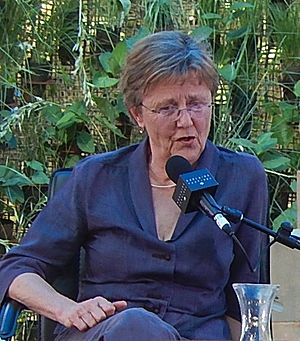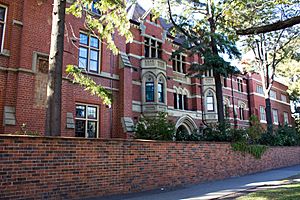Helen Garner facts for kids
Quick facts for kids
Helen Garner
|
|
|---|---|

Garner in 2015
|
|
| Born | Helen Ford 7 November 1942 Geelong, Victoria, Australia |
| Occupation | Novelist, short-story writer, journalist |
| Education | University of Melbourne |
| Notable works | Monkey Grip The First Stone Joe Cinque's Consolation This House of Grief |
| Notable awards | Victorian Honour Roll of Women (2001) |
| Spouse | Bill Garner (1967–71) Jean-Jacques Portail (1980–85) Murray Bail (1992–2000) |
| Children | Alice Garner |
Helen Garner (born Helen Ford on November 7, 1942) is a famous Australian writer. She writes novels, short stories, and articles as a journalist. Her first novel, Monkey Grip, was released in 1977. It immediately made her a new and important voice in Australian literature. Today, many people consider it a classic.
Garner is known for using her own life experiences in her stories. This has made her books, like Monkey Grip and The Spare Room (2008), very popular.
Throughout her career, Garner has written both fiction (made-up stories) and non-fiction (true stories). She became well-known for her book The First Stone (1995). It was about a serious disagreement that happened at a university college. She has also written for movies and plays. Garner has won many awards for her work.
Garner has written three true-crime books. These books look at real-life events and the justice system. The Australian Broadcasting Corporation (ABC) has called her one of Australia's "most important and admired writers." The newspaper The Guardian called her "Australia's greatest living writer."
Contents
Early Life and Education
Garner was born Helen Ford in Geelong, Victoria. She was the oldest of six children. Her sister, Catherine Ford, is also a writer. Garner said she grew up in an "ordinary Australian home—not many books and not much talk."
She went to several schools, including The Hermitage in Geelong. There, she was a top student. After high school, she moved to study at the University of Melbourne. She earned a Bachelor of Arts degree in English and French.

From 1966 to 1972, Garner worked as a high school teacher. In 1968, she married Bill Garner. Their daughter, Alice Garner, was born in 1969. Helen and Bill's marriage ended in 1971.
In 1972, Garner lost her teaching job at Fitzroy High School. This happened after she had an unapproved discussion with her students. The case was talked about a lot in Melbourne, which made Garner well-known.
Writing Career
Famous Fictional Stories
Garner became a famous writer at a time when there were not many well-known female authors in Australia. From the start, people noticed her realistic writing style.

Her first novel, Monkey Grip (1977), is about a group of young artists and single parents living in shared houses in Melbourne. The story focuses on a single mother named Nora. She is in love with a man named Javo, who is not very reliable. Garner wrote the book in the reading room of the State Library of Victoria.
She later said that the book was based on her own diaries. The characters were inspired by people she knew. Monkey Grip was a big success. It won the National Book Council Award in 1978 and was made into a movie in 1982.
Garner continued to use her own life as inspiration for her stories. Her other novels include The Children's Bach (1984) and Cosmo Cosmolino (1992). In 2008, she published The Spare Room. This fictional book is about taking care of a friend with a serious illness. It was based on her experience with her friend, Jenya Osborne.
Not everyone liked Garner's work. Some critics felt her writing was too much like a diary. However, many others praised her. Critic Peter Craven said her book The Children's Bach proved she was a skilled writer, not just someone telling her own stories.
Writing for the Screen
Garner has also written for movies and television. She wrote the screenplay for the movie version of Monkey Grip (1982). She also wrote Two Friends (1986) for TV, which was directed by Jane Campion. Another one of her screenplays was The Last Days of Chez Nous (1992), directed by Gillian Armstrong. This film was inspired by complicated family relationships.
Writing True Stories
Garner has written non-fiction throughout her career. In 1993, she won a Walkley Award for an article she wrote for Time magazine about a court case.
One of her most famous non-fiction books is The First Stone (1995). It tells the story of a major disagreement at Ormond College in 1992. The book was a bestseller in Australia but also caused a lot of debate. Garner received angry letters from people who disagreed with her views.
Her other non-fiction books include True Stories: Selected Non-Fiction (1996) and The Feel of Steel (2001). She also wrote two more true-crime books: Joe Cinque's Consolation (2004) and This House of Grief (2014). These books explore difficult real-life events and the legal system.
Common Themes in Her Work
Garner's books explore many different ideas. She often writes about love, loss, family, and growing older. She also looks at how people behave and the choices they make.
Her books often show what life is like in Australia, especially in the city of Melbourne. Many readers feel that she captures the feeling of the city perfectly.
Her non-fiction books often look at the Australian justice system. They ask questions about how society deals with difficult situations and why people do the things they do. Critics have said that Garner is very honest in her writing. She is not afraid to explore complicated and uncomfortable topics. She often writes about ordinary people who find themselves in extraordinary situations.
Personal Life
After her first marriage ended, Garner was married two more times. Her second husband was Jean-Jacques Portail, and her third was the Australian writer Murray Bail. She is no longer married.
She has one child, Alice Garner, from her marriage to Bill Garner. Alice is also an author, as well as a musician and historian.
In 2003, a portrait of Helen Garner called True Stories was a finalist in the Archibald Prize, a famous Australian art competition.
Awards and Recognition
Helen Garner has won many awards for her writing. Here are some of them:
- 1978: National Book Council Award for Monkey Grip
- 1986: South Australian Premier's Awards for The Children's Bach
- 1986: New South Wales Premier's Literary Awards for Postcards from Surfers
- 1993: Walkley Award for Best Feature Writing
- 2005: Ned Kelly Awards for Best True Crime for Joe Cinque's Consolation
- 2008: Victorian Premier's Literary Awards for The Spare Room
- 2015: Ned Kelly Award for Best True Crime for This House of Grief
- 2016: Windham–Campbell Literature Prize for her non-fiction work
- 2019: Australia Council Award for Lifetime Achievement in Literature

